What is Time? Did We Really Know All About Time.
TIME , Physics is the only science that explicitly studies time, but even physicists agree that time is one of the most difficult properties of our universe to understand.We all mark days with clocks and calendars, but perhaps no timepiece is more immediate than a mirror.
The changes we notice over the years vividly illustrate science's "arrow of time" -- the likely progression from order to disorder. We cannot reverse this arrow any more than we can erase all our wrinkles or restore a shattered teacup to its original form.
 |
Is It Possible To Reverse Time!!
To achieve the time reversal, the research team developed an algorithm for IBM's public quantum computer that simulates the scattering of a particle. In classical physics, this might appear as a billiard ball struck by a cue, traveling in a line. But in the quantum world, one scattered particle takes on a fractured quality, spreading in multiple directions. To reverse its quantum evolution is like reversing the rings created when a stone is thrown into a pond.In nature, restoring this particle back to its original state -- in essence, putting the broken teacup back together -- is impossible.
The main problem is that you would need a "supersystem," or external force, to manipulate the particle's quantum waves at every point. But, the researchers note, the timeline required for this supersystem to spontaneously appear and properly manipulate the quantum waves would extend longer than that of the universe itself.
Undeterred, the team set out to determine how this complexity might be overcome, at least in principle. Their algorithm simulated an electron scattering by a two-level quantum system, "impersonated" by a quantum computer qubit -- the basic unit of quantum information -- and its related evolution in time. The electron goes from a localized, or "seen," state, to a scattered one. Then the algorithm throws the process in reverse, and the particle returns to its initial state -- in other words, it moves back in time, if only by a tiny fraction of a second.
Given that quantum mechanics is governed by probability rather than certainty, the odds for achieving this time-travel feat were pretty good. The algorithm delivered the same result 85 percent of the time in a two-qubit quantum computer.
"The results also give a nod to the idea that irreversibility results from measurement, highlighting the role that the concept of 'measurement' plays in the very foundation of quantum physics.
This is the same notion Austrian physicist Erwin Schrödinger captured with his famous thought experiment, in which a cat sealed in a box might remain both dead and alive until its status is monitored somehow. The researchers suspended their particle in this superposition, or form of quantum limbo, by limiting their measurements.
Facts About Time:-
4.The oldest known object on Earth is a 4.4-billion-year-old crystal, a zircon, that was found in Jack Hills in Western Australia. It's only 160 million years younger than the Earth itself.
Source : Internet , CNN,Blogs
Image and Video Editor :- Mr Aman Kashyap
Text Editor : Aman Kashyap, Ankit Yadav.
Special Thanks : MIPT Scientist , The Geek Orthant Members







































